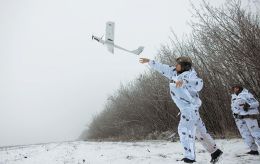EU rejects Spain's plan on using frozen Russian assets - Politico
 EU rejects Spain's plan on using frozen Russian assets (Getty Images)
EU rejects Spain's plan on using frozen Russian assets (Getty Images)
Most European Union countries did not support the proposal put forward by Spain on the use of funds obtained from frozen Russian assets to support Ukraine, according to Politico.
"Several ambassadors from the bloc’s 27 governments argued that an idea drawn up by Spain, in its role at the helm of the EU’s rotating six-month presidency, would not give Ukraine’s economy the urgent boost it needs, and instead risks undermining the EU’s commitment to provide support to Kyiv," the media says.
If Spain's initiative is implemented, it may take months or even years for Ukraine to receive the funds, officials revealed.
Spain's plan
According to the proposal received by Politico, Madrid calculated that the income from reserves of the Russian Central Bank frozen in the EU could bring Ukraine between 15 and 17 billion euros by 2027.
How the Spanish side conducted these estimates remains unclear.
During discussions among EU country representatives, there were assumptions that Spain's idea of using funds from frozen assets was unnecessary, as all bloc countries, except Hungary, agreed on increasing financing for Ukraine.
Officials state that any Russian income should be additional to what is approved to help Ukraine, not a substitute for it.
Risks
Spain's proposal has raised skepticism from several bloc governments, including France and Germany.
Additionally, the European Central Bank is concerned that such an initiative could cause instability for the euro currency.
The article notes that criticism was especially sharp at yesterday's meeting of EU envoys on December 5. Any decision on the use of seized Russian assets requires unanimity from all 27 EU member countries.
Use of frozen Russian assets
For several months, European officials have been exploring ways to extract income from approximately $300 billion in Russian assets blocked after the start of Russia's large-scale invasion of Ukraine.
Most of the frozen currency reserves of Russia are in the EU. For example, around $180 billion is held in the Belgian clearinghouse Euroclear.
As the European Commission says, it aims to provide Ukraine with $17 billion in grants plus $33 billion in low-interest loans by 2027 to prevent the country's financial collapse.
If these funds do not come from frozen assets income, they will need to be financed from other sources.
Negotiations on obtaining income from these assets are part of the Commission's plan to spend an additional $66 billion to cover unforeseen expenses.
As the EU's executive director says, the bloc's treasury has been depleted by numerous crises, namely the pandemic and Russia's large-scale military aggression against Ukraine.
Confiscated Russian assets
Ukraine, along with international partners, is working on creating the opportunity to confiscate frozen Russian assets, including state assets. These funds are intended for the recovery of Ukraine, totaling almost $500 million.
Earlier reports indicated that the European Commission would meet with EU officials and propose legal grounds for obtaining income from frozen Russian assets.

